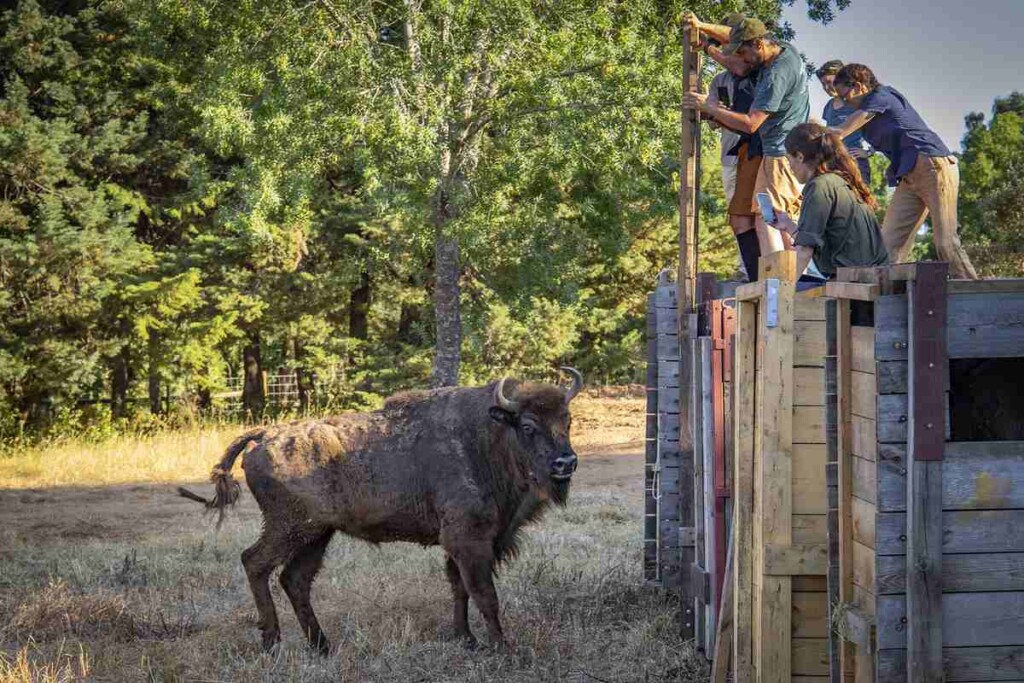"Dream, Dream, Dream! Conduct these dreams into thoughts, and then transform them into action."
- Dr. A. P. J. Abdul Kalam
"Dream, Dream, Dream! Conduct these dreams into thoughts, and then transform them into action."
- Dr. A. P. J. Abdul Kalam
11 Jun 2024
The sighting of a small herd of bison in a vast Portuguese valley marks a historic moment for Rewilding Europe. For the first time since the Last Glacial Maximum—over 20,000 years ago—bison have returned to Portugal. This period, also known as the Last Glacial Coldest Period, was when ice sheets reached their greatest extent, profoundly affecting Earth's climate and landscapes. It's considered to be the key to preventing catastrophic wildfires, curbing the spread of invasive species, and promoting endemic biodiversity.
During the Last Glacial Maximum, vast ice sheets covered Northern North America, Europe, and Asia, significantly impacting the planet by expanding desert areas and lowering sea levels. Today, European wood bison are celebrated as one of the best resources for restoring Europe's wilderness to its untamed glory. Their populations are flourishing from Poland to Romania and even the UK, heralding a new era of conservation and ecological balance.
The European bison and the steppe bison used to wander the forests and scrublands that once covered all of Europe. To enhance natural ecosystems, countries throughout the Old World are currently working to restore these massive grazers into wild regions.
A Milestone Moment ~

Wild Bison Getting Restored In the Wild In Romania
( Source: Google Images)
The group Rewilding Portugal, which sourced the animals from the woods of northern Poland, where more than 4,000 bison roam freely, will collaborate with the management of the incoming European bison. According to Pedro Prata, the leader of the Rewilding Portugal project, "We are viewing this translocation as a pilot." The bison's adaptation to the local environment and climate will be closely observed. Since the Rewilding Portugal team has never managed bison before, we are also learning a lot from this experience. The team members will get management training for the bison. It will be novel not only for the team but also, in a sense, novel for Portugal. Not only have no remains of the European bison been found in the nation, but no remains have been found anywhere on the Iberian Peninsula.
The steppe bison, which originated in Portugal 10,000 years ago and is the ancestor of the contemporary European bison, is where the scientific proof has to go. Nonetheless, research on relocated bison in Spain has demonstrated that they thrive in the country's hot, dry climate. Bison contribute to the preservation of mosaic landscapes rich in biodiversity, comprising grassland, scrub, and forest, as well as various micro-habitats supporting a diverse array of plant and animal species, utilizing grazing, foraging, trampling, and fertilizing. Studies on the related American bison conducted in North America and Europe have brought this to light. The soil and vegetation can both absorb more atmospheric carbon as a result of these same interactions.
Trusting The Process ~

The Beast of the food world, the European Bison ~
( Source: Google Images)
The European bison still has to overcome several obstacles, even with the tremendous advancements during the past ten years. These comprise a minuscule gene found in American bison, health risks (new illnesses and epidemics have been documented), restricted living quarters, seclusion, poaching, and inadequate environment for reintroduction. Only eight free-living subpopulations (with a combined total of 150 animals) are still viable, with the majority of subpopulations continuing to be small and isolated. The IUCN (International Union for Conservation of Nature) and its Bison Species Specialist Group are currently working on a second bison action plan that will help to address many of these unresolved challenges. Following the publishing of this plan, Rewilding Europe's own Bison Rewilding Plan will also be revised.
What Does Future Prospect Look Like ~
Europe currently stands at a crossroads. People are moving from rural areas to cities and coastal locations in search of new horizons for the first time in many centuries. Many animals are now able to naturally recolonize portions of their former range because of a combination of factors including a stronger legislative framework, specialized species protection programs, the creation of a pan-European protected area net, labor, and increased public interest in wildlife. In light of this, and despite the difficulties encountered in facilitating its resurgence, the outlook for the European bison is positive. This species, which was once in danger of going extinct, is now writing the next chapter in its ongoing history as free-roaming populations continue to grow and explore new areas, improving biodiversity and enriching the lives of those they coexist with.